Background and Strategies
For over twenty years I have observed the regulation behavior and the functional behavior of healthy and ill people with standardized Infrared-Thermography. The images of the formation of a chronic illness correspond in many cases. Functional restrictions are regularly preceded in the upper abdomen.
In the first place the liver function is involved here with a typical complaint picture:
- Disturbances in sleeping through the night
- Constipation
- Restriction of the right sided head torsion
- A more right sided vertex headache, radiating behind the eyes
- Right shoulder-arm syndrome
- Nightly thirst
- Swollen tear sacs (upper, lateral portion of the lower lids)
- Meteorism
- Fatigue
- Perianal itch
- Hemorrhoids
- Dry mucous membranes
If a restriction of the pancreas function goes on top of this, suddenly varying stool qualities appear, the head torsion is restricted on both sides and also the headaches shift between right and left.
The result of these reduced functions in the upper abdomen is a changing bacterial milieu and afterwards an irritable bowel. For the tissue situation an irritable bowel means: enlarged vessels and reinforced cellular resistance in the intestinal wall.
Through the enlarged vessels food components can reach through the intestinal wall into the connective tissue and the blood, with the result of an Immunoglobulin-G formation going against these materials. By renewed contact with these foods a histamine distribution takes place after a delayed reaction (two hours to two days). In these cases the acute symptomatology comes to:
- Diarrhea
- Slight coughing / cough stimulus
- Tachycardia
- Runny head cold
- Urge to urinate
- Itching skin
- Forgetfulness
- Edema
- Vomiting
A regular histamine distribution based on a food incompatibility can lead to complaints like:
- Eczema
- Arthritis
- Congested nose
- Asthma
- Mucous membrane polyps (intestine, bladder, uterus, ENT area)
- Migraines
- Burst vessels
- Depression
- Anxieties
- Exhaustion
- Bed wetting (children)
- Nephrotic syndrome
- Muscle pain
- Stomach ulcers
- Joint pains
But how can you treat this symptomatology satisfactorily as well as causally?
I am confident of the fact that the therapy must begin primarily in the organs of the upper abdomen, since these are connected in series with the bowel and cause a dysbiosis through their reduced function. Thus the essence of the therapy is to relieve the organs of the upper abdomen and to stimulate their function.
When it concerns the liver I pay attention to the fact that the patients take in aflatoxin- and ochratoxin-free foods. In the first place coffee, but also nuts, peanuts, pistachios, grains, seasonings and figs are therefore strictly avoided.
The flow of bile is further stimulated with artichokes and curcuma preparations, for liver protection Saint Mary’s Thistle (silymarin) preparations are given in addition.
For a pancreas problem it is valid: no alcohol, no psychiatric drugs, preferably no contact with solvents.
As far as I know unfortunately there are no phytotherapeutics for direct increase of the pancreas function. Therefore in these cases I carry out an indirect treatment. Pancreozymin and secretin stimulation by frequent small meals and thorough chewing are used in these cases. Furthermore, support of the pancreas function with bile producing remedies is recommended as mentioned above already in the liver therapy. The meal should be taken in silence in order to support the parasympathicotonia. Fats and carbohydrates are eaten separately by the patient to increase enzyme production. In every case proteins should be “predigested”, and thus be cooked or baked.
Concept of a Primary Therapy for Irritable Bowel
Myrrh, chamomile and charcoal work to detoxify and calm. Probiotics strengthen the bowel colonization and prebiotics like inulin help more to settle the bifidobacteria and further to soften the stool. Bacteria bouillon reforests the bacterial settling. And an omission- and rotation- diet decreases the above mentioned histamine caused reactions.
Saponine, as found in spinach and legumes, but also citrus fruits are under suspicion of causing a Leaky Gut Syndrome and are therefore to be avoided.
Unfortunately this organ related therapy brings no long term success. Although on the basis of the treatment the upper abdomen symptomatology disappears, the irritable bowel and the food incompatibility however remain resistant to therapy.
Testing which foods are not tolerated gives a greater security to the patient in his diet and thereby causes an attenuation of the symptomatology of the food incompatibility. But the cause is not treated by this and additional new food incompatibilities appear.
It is thus about time to rethink.
During my previous practice activity I have defined functional disturbances through the thermographic statements and never through increased enzyme values in the blood count, because here remarkable values are only registered with cell decay.
But how are functional disturbances of the bowel represented in the thermogram? And what can you do for it as the cause of the formation of a Leaky Gut Syndrome, and maybe even many other unclear disease processes?
A Red Back in the Functional Thermogram
In thermograms chronically ill patients fall out in addition to the blue, i.e. cold bowel into the regular red hot tolerance in the lower back area. I classified this phenomenon as acidosis, since these patients were basically over acidified (Fig. 1 and 2).
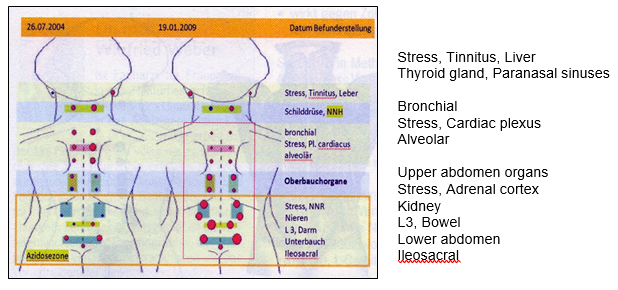
Figure 1
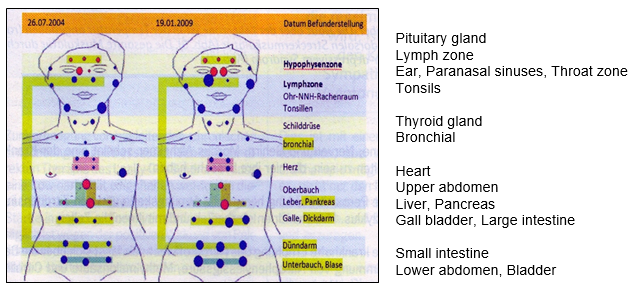
Figure 2
Figure 1 and 2: A time window of five years lies between the images which show the thermograms of a 45 year old patient who during 2008 was diagnosed with bladder cancer, a breast cancer and a severe dysplasia in the cervix area of the uterus.
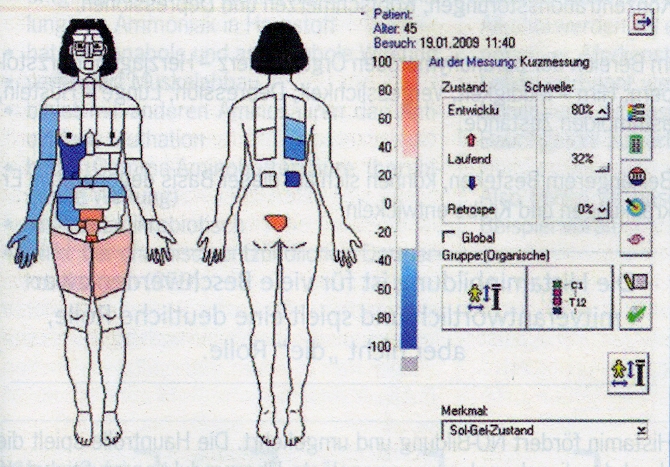
Figure 3: Impedance analysis with the AMSAT-HC device with the same patient in 1/19/2009. The liver and intestinal areas are remarkable. The sacral bone area and the lower abdomen are reactive.
You find this manifestation with inflammation, after a trauma, with stress, after an insulin injection and after absorption of short chain carbohydrates like starch, sugar, alcohol, etc.
With all these events an elevated and fluctuating insulin level is in play. We find the causes for an insulin increase in the literature with:
- Inflammation (increased blood sugar values)
- Trauma (increased blood sugar values)
- Chronic stress (cortisol increase leading to a blood sugar increase)
- Injection of insulin (leads to Type 2 diabetes and an increased insulin resistance)
- Absorption of short chain carbohydrates
- Increase of fatty and amino acids
- Increase of parasympathetic activity
- Insulin resistance through aging
In these cases the glucose metabolism is raised, and glucose is used either as an energy carrier or is modified into its glycogen storage form. In this case it should be considered that the glucose of the erythrocytes, the bowel mucosa and the epithelial cells of the kidney can take up glucose energy independently through diffusion, whereas the liver, skeletal musculature and fatty tissue only store glucose over insulin. For this, energy is used which creates heat (Fig. 4 to 6).
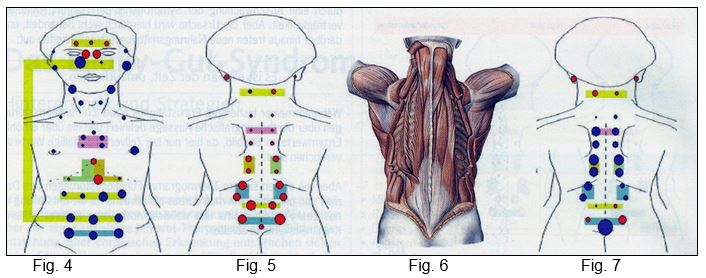
Figure 4-7, from left to right: Insulin dependent glucose storage in the liver. The skin over the liver zone is raised in temperature (red points). A similar picture is found over the caudal muscle packet of the dorsal extensor muscles (Fig. 5). The entire musculature emits through the skin (Fig. 6). A cold back during intake of lithium for manic depressive syndrome (Fig. 7).
If this function of compulsory energy storage of glucose is interrupted for instance by a dose of lithium for mania, the skin over the musculature cools off, and symptoms of muscle weakness like fasciculations, myalgias, tremor, ataxia and on the other hand also hyperglycemia kick in. (Fig. 7).
We are slowly approaching the cause:
The primary cause of dysbiosis, irritable bowel and Leaky Gut Syndrome could therefore lie in faulty nutrition, hormone variations and stress. In this case you would understand by faulty nutrition an increased absorption of short chain carbohydrates (wheat, sugar, starch, alcohol). Stress would be evaluated as the faulty processing of external influences and the absorption of additives (preservatives, dyes, sugar substitutes, pesticides, bisphenol A, acrylamide, etc.). Stress states are brought on and supported by these circumstances: behavior stress, nutrition stress, hormone stress, metabolism stress, immune stress and further self generating oxidative and nitrosative stress.
Premature Aging
It is remarkable that for women above all in the ages between 40 and 50 years, thus with the beginning of menopause, the nitrogen oxide (NO) metabolism explodes. Here also the most likely cause of these phenomena lie in an increased blood glucose level and consequently with it an increase of insulin formation.
How does the hormonal situation for a woman of 40 look? Estrogens and progesterone drop down to a tenth of their original value. As a countermove thyroxin and cortisol are increasingly formed. Cortisol works as an antagonist for insulin (insulin resistance) and with it increasing blood glucose but also promotes the beginning of body fat and blocks immune resistance.
For men testosterone already drops from the 25th year. Testosterone supports muscle mass, concentration and memory and reduces body fat mass. A similar effect is manifested by growth hormone, which additionally promotes immune resistance, libido and bone construction. It works antagonistically against insulin. As both hormones drop with increasing age, the mentioned effects decrease and insulin increases, and thus also the fat buildup and the hunger feeling.
The Cause
Now how can you imagine the formation of Leaky Gut Syndrome? An increase of blood glucose inevitably leads to counter controls through increasing insulin levels. This promotes NO production through a stimulation of the nitrogen oxide synthase. This has further influence on the formation of cyclic guanosine monophosphates which exert a positively protecting influence on the vessel metabolism.
If the NO metabolism is too strongly kicked off by an increased glucose supply over the stress conditioned formation of adrenalin, TRH or cortisol, the vessel protection and NO are tipped over from nitrite to nitrate or oxidized nitrotyrosine. The result: Vessel tonus increases, plaques originate, thrombosis and embolism likelihood climbs.
Unfortunately this metabolism changeover not only affects the endothelial system, but also the i-NOS, b-NOS, n-NOS as well as the organs, nerves and brain. Morbus Alzheimer seems to be one of the diseases which have their cause here.
The peroxynitrite formation hinders the respiration chain and the citric acid cycle. Mitochondria die and with them the cells.
The disease increase of the nitro-metabolism can be proven by a determination of the nitrophenylacetic acid, methylmalonic acid and citrulline in the urine.
In the body nitrate and nitrotyrosine lead to a formation of chronic inflammations.
- In the area of the mucous membranes to irritable bowel, irritable stomach, irritable bladder
- To polyp production, gluten intolerance, immune disturbances, lactose or fructose intolerance, slight coughing, and asthmatic complaints
- In the area of the organs to reduced function and cell death
- In the brain area concentration disturbances, headaches and depression.
- In the area of the parenchymatous organs:
- Heart – tachycardia, cardiac arrhythmia
- Brain – fatigue, forgetfulness, depression
- Lungs – coughing slightly, asthmatic states.
On this basis over a longer existence degenerative illnesses and cancer can develop.
Histamine production is jointly responsible for many complaints and plays a clear role – but not “the” role.
Histamine promotes NO production and vice versa. The main role plays through the insulin variations bringing on overproduction of nitrogen monoxide.
An Optimal Therapy for Leaky Gut Syndrome
After making a diagnosis and a thermographic and/or laboratory-chemical proof of Leaky Gut Syndrome by an IgG-1-3 determination, to be effective the organ symptomatology should be treated with the systemic treatment according to the organ pattern mentioned above.
For prevention of accompanying chronic inflammations, in stress states and for direct therapy of Leaky Gut Syndrome a Low Carb Diet must be kept. In this diet sugar, wheat flours and starchs in all forms are avoided. A daily apple is because of the positive effect of the pectin on the bowel duty. Yeast and cow’s milk should be strictly avoided.
In any case a 3 month therapy with 3 grams of glutamine per day is suitable.
Glutamine has the following positive effects:
- Rebuilds glucose in glycogen
- Detoxifies liver and brain by transformation of ammonia into urea
- Has an anabolic and an anticatabolic effect
- Prevents muscle reduction
- With other amino acids forms the antioxidant glutathione
- Forms gamma-aminobutyric acid (calming effect)
- Works antimicrobically
- Is effective for chronic inflammatory bowel diseases
- Is effective against villi atrophy and closes a porous intestine (Leaky Gut)
If methylmalonic acid and/or citrulline are increased in the urine, vitamin B12 must be given to counteract against an insulin increase, a TRH increase, an intracellular acidosis and an increased NO formation. At the same time the hindering effect of NO on the citrate cycle is indirectly canceled.
For an increase of nitrophenylacetic acid high dosages of alpha lipoic acid, coenzyme Q10, L-carnitine and folic acid have been proven to prevent premature cell death through nitrotyrosine formation.
Another therapy possibility which is regularly neglected is the desire of the body to transfer from sympathicotonia into vagotonia.
This is possible with a series of relaxation technologies, but also targeted with craniosacral therapy. It is the sense of this therapy, not only to free the patient from his high stress levels, but also to prompt and to stimulate the upper abdomen and bowel function.
“We live in a world which is identified by stress. This stress is unavoidable and makes us sick.”
This much used statement is wrong. We can learn to live more consciously and more positively. We should limit ourselves to natural food and avoid short chain carbohydrates. “Pleasure” poisons like nicotine, caffeine and alcohol are reduced to a minimum and negative media stress should be banished from our life. We must learn again to count on our inner voice, our gut feeling.
So we lead the way for our patients with a good example.

Figure 8: The evolution chain for peroxynitrite formation. Peroxynitrite hinders the respiration chain and the citric acid cycle.
A NOTE FROM THE DIRECTOR: The preceding article taken from a recent CO’MED journal issue was particularly interesting for the almost seamless manner in which he combines various diagnostic and therapeutic methods. We will see the introduction of a quality American made Thermography device during the forthcoming Biological Medicine Symposium 2010 and here is an example of a very practical application of that diagnostic method. Then you can see how his thermography findings are diagnostically confirmed with the AMSAT-HC. Then add the nice blend of therapeutics like Mayr (chewing), the work of Dr. Kremer and Dr. Sacher in regard to the NO factors, glutathione, causal chains and so on. A very good overview and practical application – all targeted at one of our most commonly presenting problems. Thank you, Dr. Weber for your article. CLWS
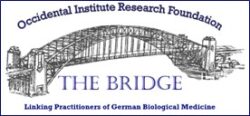 An Exclusive Translated Article for Members
An Exclusive Translated Article for Members
From THE BRIDGE Newsletter of OIRF
Published February 2010
From an article in CO’MED, No. 6, 2009
Machine Translation by SYSTRAN, Lernout & Hauspie, LogoMedia & Promt
Translation & redaction by: Carolyn L. Winsor, OIRF
© Copyright 2009, Dr. med. Winfried Weber, Darmstadt, Germany



